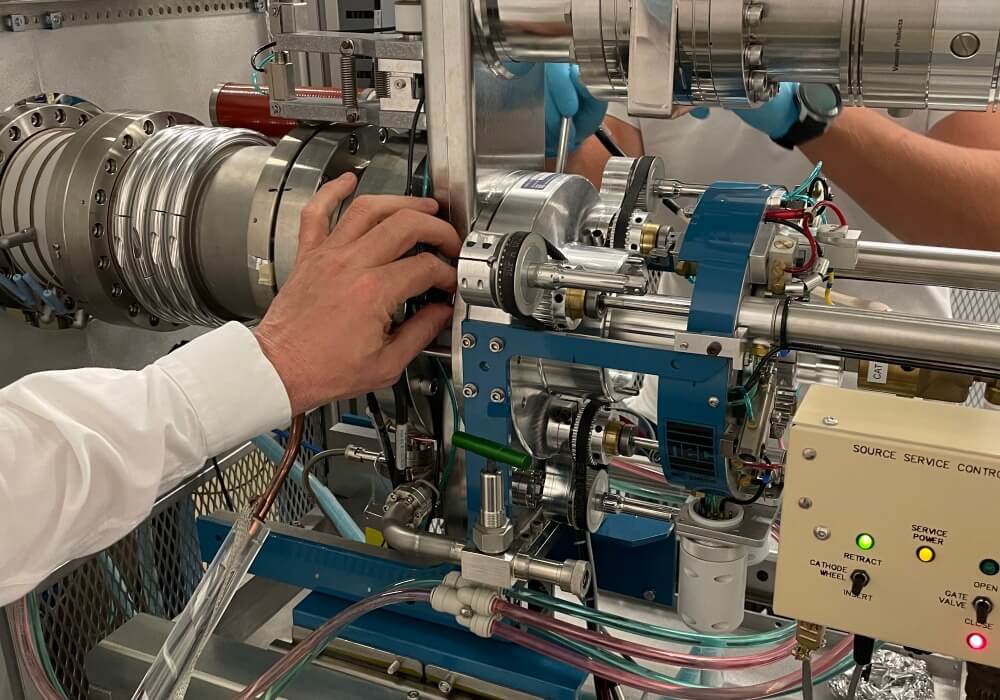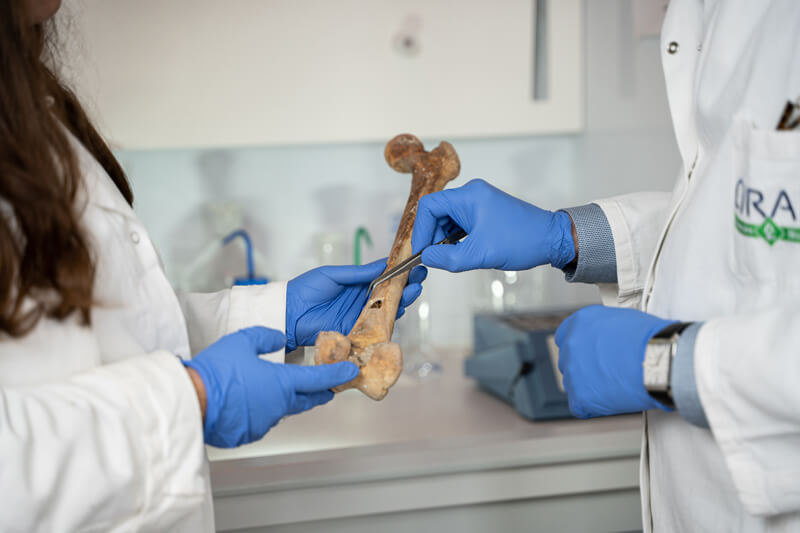
CARBON 14 DATING BY AMS
Carbon 14 dating is the primary service we use in archaeometry. Our scientists date all of your organic materials found in archaeological contexts by measuring the concentration of carbon 14, 13, and 12 using a particle gas pedal coupled to a mass spectrometer (AMS).
C14 dating by AMS, for accurate, reliable and fast results
C14 dating by AMS (gas pedal coupled mass spectrometry) allows us to date all organic archaeomaterials found during archaeological excavations. Thanks to state-of-the-art technologies, our scientists obtain precise and rigorous results in order to calibrate by physical measurements the chronology of stratigraphies.
Aware of the constraints in preventive archaeology, we respect deadlines of 10 working days maximum to provide our dating and calibrations.
The carbon-14 principle, for accurate dating of your materials
Carbon-14 (also called radiocarbon) is a radioactive isotope of carbon, in that it is unstable (it will change over time). All living organisms possess this isotope. During the life of the organism, the concentration of carbon 14 will be constant. From the moment an organism dies, the quantity of carbon 14 decreases proportionally in time. Its concentration decreases by half every 5568 years.
Mass spectrometry (AMS) is a state-of-the-art technique for dating very small fragments. The amount of pure carbon required is on the order of 1 mg. The accuracy of the measurement will be ± 25 to 30 years on the raw age. And the analysis requires only a few hours.

Carbon-14 dating by AMS
Carbon-14 dating by AMS is one of our specialties. With this method, we can date organic materials of all kinds such as charcoal, bones, teeth, seeds, organic residues, or even wood and shells. Before the carbon-14 measurements, the samples undergo chemical pre-treatments, in order to remove potential pollutants and extract the datable material: cellulose for wood or collagen for bones for example.
Our teams of doctors and engineers adapt the pre-treatment processes according to the material. This will involve extracting the carbon and forming a graphite pellet, and analyzing the stable isotopes of carbon and nitrogen. Despite these numerous steps, we propose a 10 business day turnaround time to provide the dates. We propose a complete analysis with the raw age and the calibrated date. We compile and comment on the results in a study report.

Treatments and Extractions
Our scientists can perform carbon-14 (or radiocarbon) analysis on all organic materials such as wood, charcoal, bones, teeth, sediments, textiles…
The bones undergo a series of preliminary treatments to extract collagen. They are treated with hydrochloric acid to remove any surface contamination and to partially deteriorate the mineral part of the bone. They are then washed with demineralized water and treated with sodium hydroxide to remove residual humic and fulvic acids. The samples are again treated with hot hydrochloric acid for extraction. They are then filtered by rinsing to recover collagen.
Graphitization and stable isotopes
Once the treatments and extractions have been carried out, the carbon must be separated from the other atoms: this is the graphitization step where the sample will be burned and the CO2 gas formed will be reduced to pure solid carbon (graphite). At the same time, stable carbon and nitrogen isotopes will be measured with an isotope ratio mass spectrometer (IRMS) and the C/N ratio will be measured with an elemental analyzer, in order to validate the quality of the collagen.
Since 2018, more than 6000 samples have been dated. CIRAM laboratories are equipped with an automated analysis and graphitization line including:
- an Elementar Vario Isotope select elemental analyzer for sample combustion, elemental nitrogen and carbon analysis, and C/N ratio determination ;
- an Elementar IRMS mass spectrometry system for determination of stable carbon and nitrogen isotope ratios (d13C, 13C/12C and d15N, 15N/14N);
- two AGE3 Ions Plus automated graphitization systems that transforms samples into graphite targets for AMS measurement.
Dating of bioapatite
Most burned bones and some bones preserved in arid environments no longer contain collagen or the collagen is severely degraded. Measurement of the C/N ratio is an indicator of collagen preservation. This ratio must be between 2.9 and 3.6 to consider a “classic” carbon 14 dating on collagen. If the C/N ratio is outside this range, we will have to date the mineral part of the bones, namely the bioapatite.
It is the CO2 of the bioapatite that will be dated. It is recovered by reaction with phosphoric acid and separated from other products by cryogenic purification. Finally, this carbon dioxide is transformed into graphite for AMS measurement.
CIRAM, specialist in carbon-14 dating by AMS
Thanks to its scientists and laboratories equipped with the latest technology, CIRAM is a specialist in archaeomaterials dating and analysis. Using the same protocols as public laboratories, CIRAM provides reliable, accurate and rapid results in accordance with the constraints of preventive archaeology.
Our scientists do not simply deliver physical measurements, we are committed to commenting and discussing the results according to the archaeological context and your issues.
What materials are datable by carbon 14?
What is the minimum quantity required?
| Materials | Minimum quantity required |
| Wood | 20-100 mg |
| Wood Charcoal | 20-100 mg |
| Organic residue | 20-100 mg |
| Grain | 20-100 mg |
| Os, tooth, ivory | 500-1000 mg |
| Shell | 50-100 mg |
| Beachrock | 50-100 mg |
| Turkey | 50-100 mg |
| Burnt Oxygen | 2000-3000 mg |
Find out about CIRAM’s other fields of expertise:
